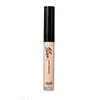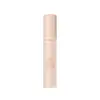What's inside
What's inside
 Key Ingredients
Key Ingredients

No key ingredients
 Benefits
Benefits

 Concerns
Concerns

 Ingredients Side-by-side
Ingredients Side-by-side

CI 77891
Cosmetic ColorantWater
Skin ConditioningCyclopentasiloxane
EmollientPhenyl Trimethicone
Skin ConditioningMica
Cosmetic ColorantButylene Glycol
HumectantCetyl PEG/PPG-10/1 Dimethicone
EmulsifyingPvp
Emulsion StabilisingPEG-10 Dimethicone
Skin ConditioningCI 77492
Cosmetic ColorantCI 77120
Cosmetic ColorantSodium Chloride
MaskingVinyl Dimethicone/Methicone Silsesquioxane Crosspolymer
Dimethicone
EmollientAluminum Hydroxide
EmollientTriethoxycaprylylsilane
CI 77491
Cosmetic ColorantDisteardimonium Hectorite
StabilisingPhenoxyethanol
PreservativePolysilicone-11
Methicone
EmollientPalmitic Acid
EmollientChlorphenesin
AntimicrobialStearic Acid
CleansingCI 77499
Cosmetic ColorantSqualane
EmollientMyristic Acid
CleansingCentella Asiatica Extract
CleansingPolygonum Cuspidatum Root Extract
AntioxidantScutellaria Baicalensis Root Extract
AstringentCamellia Sinensis Leaf Extract
AntimicrobialGlycyrrhiza Glabra Root Extract
BleachingChamomilla Recutita Flower Extract
MaskingRosmarinus Officinalis Leaf Extract
AntimicrobialCI 77891, Water, Cyclopentasiloxane, Phenyl Trimethicone, Mica, Butylene Glycol, Cetyl PEG/PPG-10/1 Dimethicone, Pvp, PEG-10 Dimethicone, CI 77492, CI 77120, Sodium Chloride, Vinyl Dimethicone/Methicone Silsesquioxane Crosspolymer, Dimethicone, Aluminum Hydroxide, Triethoxycaprylylsilane, CI 77491, Disteardimonium Hectorite, Phenoxyethanol, Polysilicone-11, Methicone, Palmitic Acid, Chlorphenesin, Stearic Acid, CI 77499, Squalane, Myristic Acid, Centella Asiatica Extract, Polygonum Cuspidatum Root Extract, Scutellaria Baicalensis Root Extract, Camellia Sinensis Leaf Extract, Glycyrrhiza Glabra Root Extract, Chamomilla Recutita Flower Extract, Rosmarinus Officinalis Leaf Extract
Water
Skin ConditioningCI 77891
Cosmetic ColorantDimethicone
EmollientHydrogenated Polyisobutene
EmollientButylene Glycol
HumectantIsododecane
EmollientLauryl PEG-10 Tris(Trimethylsiloxy)Silylethyl Dimethicone
EmulsifyingTrimethylsiloxysilicate
EmollientAcrylates/Polytrimethylsiloxymethacrylate Copolymer
Skin ConditioningVp/Va Copolymer
PEG-10 Dimethicone
Skin ConditioningPentylene Glycol
Skin ConditioningCI 77492
Cosmetic ColorantSorbitan Isostearate
EmulsifyingDisteardimonium Hectorite
StabilisingSodium Chloride
MaskingDimethicone/Vinyl Dimethicone Crosspolymer
Skin ConditioningCI 77491
Cosmetic ColorantTriethoxycaprylylsilane
Phenoxyethanol
PreservativeAluminum Hydroxide
EmollientCI 77499
Cosmetic ColorantCaprylyl Glycol
EmollientPEG-10
HumectantEthylhexylglycerin
Skin ConditioningParfum
MaskingLinalool
PerfumingGeraniol
PerfumingWater, CI 77891, Dimethicone, Hydrogenated Polyisobutene, Butylene Glycol, Isododecane, Lauryl PEG-10 Tris(Trimethylsiloxy)Silylethyl Dimethicone, Trimethylsiloxysilicate, Acrylates/Polytrimethylsiloxymethacrylate Copolymer, Vp/Va Copolymer, PEG-10 Dimethicone, Pentylene Glycol, CI 77492, Sorbitan Isostearate, Disteardimonium Hectorite, Sodium Chloride, Dimethicone/Vinyl Dimethicone Crosspolymer, CI 77491, Triethoxycaprylylsilane, Phenoxyethanol, Aluminum Hydroxide, CI 77499, Caprylyl Glycol, PEG-10, Ethylhexylglycerin, Parfum, Linalool, Geraniol
Ingredients Explained
These ingredients are found in both products.
Ingredients higher up in an ingredient list are typically present in a larger amount.
Aluminum Hydroxide is a form of aluminum. It can be naturally found in nature as the mineral gibbsite. In cosmetics, Aluminum Hydroxide is used as a colorant, pH adjuster, and absorbent.
As a colorant, Aluminum Hydroxide may add opacity, or reduce the transparency. Aluminum hydroxide is contains both basic and acidic properties.
According to manufacturers, this ingredient is an emollient and humectant. This means it helps hydrate the skin.
In medicine, this ingredient is used to help relieve heartburn and help heal ulcers.
There is currently no credible scientific evidence linking aluminum hydroxide in cosmetics to increased cancer risk.
Major health organizations allow the use of aluminum hydroxide in personal care products and have not flagged it as a carcinogenic risk at typical usage levels.
Learn more about Aluminum HydroxideButylene Glycol (or BG) is used within cosmetic products for a few different reasons:
Overall, Butylene Glycol is a safe and well-rounded ingredient that works well with other ingredients.
Though this ingredient works well with most skin types, some people with sensitive skin may experience a reaction such as allergic rashes, closed comedones, or itchiness.
Learn more about Butylene GlycolCi 77491 is also hydrated iron III oxide. It's sole purpose is to give a red/pink hue to products.
Iron III oxides are classified as inorganic chemicals for coloring.
Synthetically created Ci 77491 is considered safer than those naturally found. This is because the synthetically created version may contain less impurities. Iron oxides are generally non-toxic and non-allergenic.
Learn more about CI 77491Ci 77492 is also hydrated iron III oxide. It's sole purpose is to give a yellow hue to products.
Iron III oxides are classified as inorganic chemicals for coloring.
Synthetically created Ci 77492 is considered safer than those naturally found. This is because the synthetically created version may contain less impurities. Iron oxides are generally non-toxic and non-allergenic.
Learn more about CI 77492Ci 77499 is also hydrated iron III oxide. It is created from mixing red and black iron oxides. This helps give shades of darkness to a product.
Iron III oxides are classified as inorganic chemicals for coloring.
Ci 77891 is a white pigment from Titanium dioxide. It is naturally found in minerals such as rutile and ilmenite.
It's main function is to add a white color to cosmetics. It can also be mixed with other colors to create different shades.
Ci 77891 is commonly found in sunscreens due to its ability to block UV rays.
Learn more about CI 77891Dimethicone is a type of synthetic silicone created from natural materials such as quartz.
What it does:
Dimethicone comes in different viscosities:
Depending on the viscosity, dimethicone has different properties.
Ingredients lists don't always show which type is used, so we recommend reaching out to the brand if you have questions about the viscosity.
This ingredient is unlikely to cause irritation because it does not get absorbed into skin. However, people with silicone allergies should be careful about using this ingredient.
Note: Dimethicone may contribute to pilling. This is because it is not oil or water soluble, so pilling may occur when layered with products. When mixed with heavy oils in a formula, the outcome is also quite greasy.
Learn more about DimethiconeDisteardimonium Hectorite comes from the clay mineral named hectorite. It is used to add thickness to a product.
It can also help stabilize a product by helping to disperse other ingredients.
Hectorite is a rare, white clay mineral.
Learn more about Disteardimonium HectoritePeg-10 Dimethicone is silicone with conditioner and emulsifier properties. It mostly acts as an emollient in skincare and and humectant in haircare.
According to the manufacturer, acidic formulations decrease the stability of this ingredient. It works best in neutral or near neutral formulations.
Phenoxyethanol is a preservative that has germicide, antimicrobial, and aromatic properties. Studies show that phenoxyethanol can prevent microbial growth. By itself, it has a scent that is similar to that of a rose.
It's often used in formulations along with Caprylyl Glycol to preserve the shelf life of products.
Chances are, you eat sodium chloride every day. Sodium Chloride is also known as table salt.
This ingredient has many purposes in skincare: thickener, emulsifier, and exfoliator.
You'll most likely find this ingredient in cleansers where it is used to create a gel-like texture. As an emulsifier, it also prevents ingredients from separating.
There is much debate on whether this ingredient is comedogenic. The short answer - comedogenic ratings don't tell the whole story. Learn more about comegodenic ratings here.
The concensus about this ingredient causing acne seems to be divided. Research is needed to understand if this ingredient does cause acne.
Scrubs may use salt as the primary exfoliating ingredient.
Learn more about Sodium ChlorideTriethoxycaprylylsilane is a silicone used to bind and stabilize ingredients.
As an emulsifier, it helps prevent ingredients from separating. This can help elongate the shelf life of products.
Triethoxycaprylylsilane is often used to coat mineral sunscreens ingredients to help give a better feel. It also helps reduce oxidative stress in sunscreens.
Learn more about TriethoxycaprylylsilaneWater. It's the most common cosmetic ingredient of all. You'll usually see it at the top of ingredient lists, meaning that it makes up the largest part of the product.
So why is it so popular? Water most often acts as a solvent - this means that it helps dissolve other ingredients into the formulation.
You'll also recognize water as that liquid we all need to stay alive. If you see this, drink a glass of water. Stay hydrated!
Learn more about Water